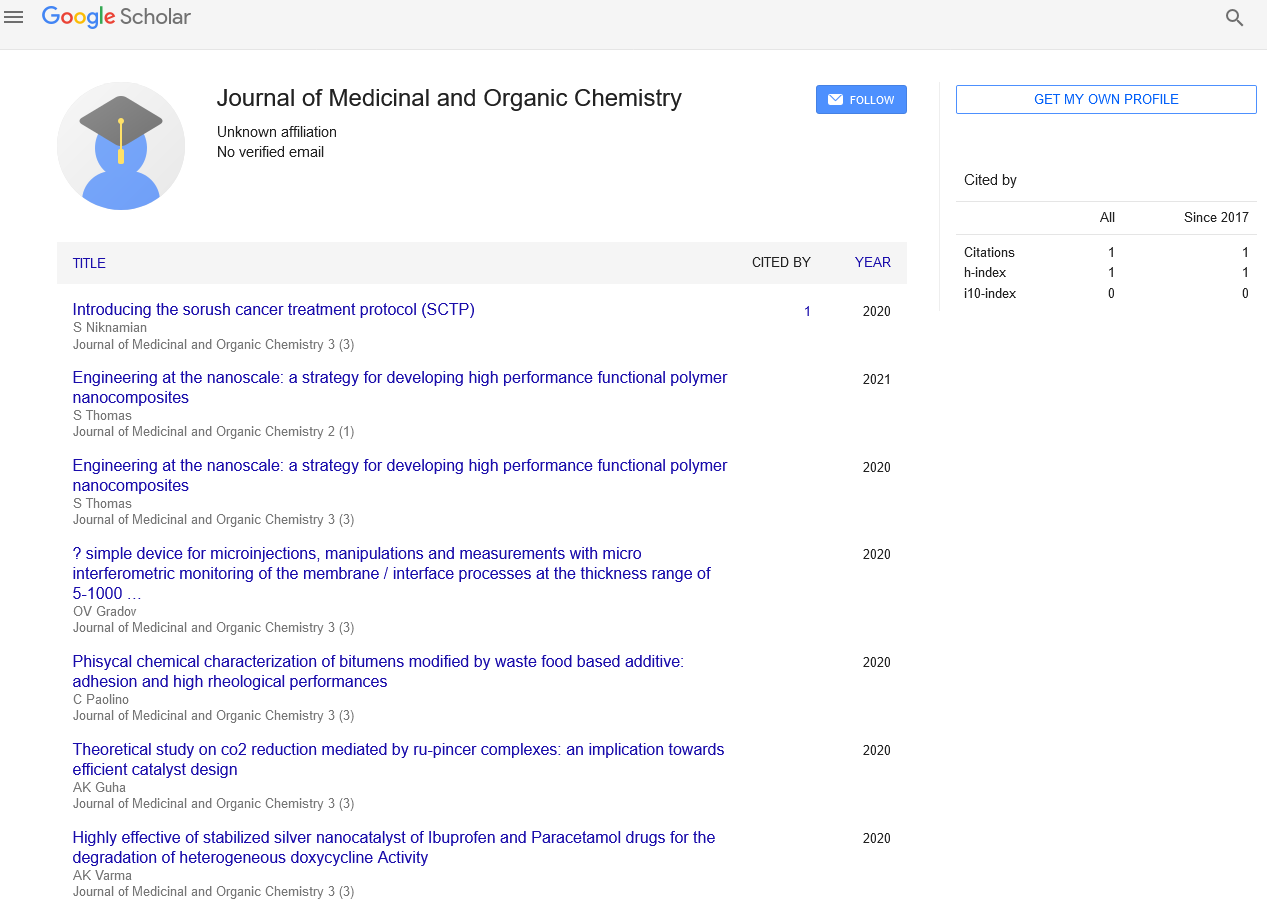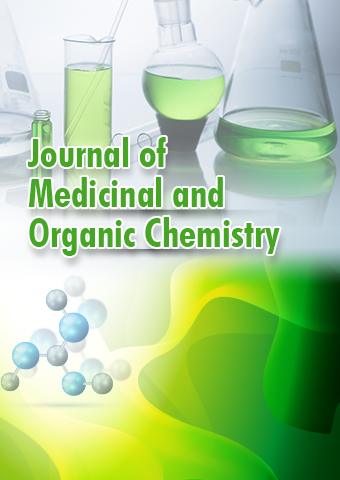Mini Review - Journal of Medicinal and Organic Chemistry (2023) Volume 6, Issue 1
Evidence Based Medicine and Use Evidence for Guideline Development
Dr. Rajeev Kumar Kar*
Department of drug Development and drug discovery, University of SRM, India
Department of drug Development and drug discovery, University of SRM, India
E-mail: rkumar.kar@gmail.com
Received: 02-Feb-2023, Manuscript No. jmoc-23-89017; Editor assigned: 06-Feb-2022, PreQC No. jmoc-23- 89017; Reviewed: 13- Feb-2023, QC No. jmoc-23-89017; Revised: 23-Feb- 2023, Manuscript No. jmoc-23-89017 (R); Published: 28-Feb-2023; DOI: 10.37532/jmoc.2023.6(1).04-06
Abstract
Quality of care can be measured using a framework provided by clinical practice guidelines. Guidelines' recommendations are used to make decisions not only in the clinical field but also about other related issues in health systems. As a result, the global standard for guaranteeing the quality of a guideline is the use of research evidence in the formulation of recommendations. Following a brief history of the need for and use of evidence in guideline development, the paper provides an overview of the four types of country-level guideline development mechanisms. The conscientious, explicit, judicious, and reasonable use of the most recent, best evidence in individual patient care decisions is known as evidence based medicine (EBM). The best research data is combined with clinical experience and patient values in EBM. Increasing the use of high-quality clinical research in clinical decision making is the goal of this movement. The clinician must acquire new abilities for EBM, such as the ability to conduct effective literature searches and evaluate the clinical literature using formal rules of evidence. Evidence-based medicine is a lifelong process of self-directed, problem-based learning in which caring for one's own patients necessitates clinically relevant information regarding diagnosis, prognosis, treatment, and other clinical and health care issues. It is not a "cookbook" with recipes, but when used correctly, it improves health care at a lower cost. The fact that traditional medicine does not take evidence into account is not the primary distinction between evidence-based medicine and EBM. Both take into account evidence; However, EBM calls for more robust evidence than has been the case in the past. The development of systematic reviews and meta-analyses, methods by which researchers identify multiple studies on a topic, separate the best ones, and then critically analyse them to come up with a summary of the best evidence that is available, is one of the greatest achievements of evidence-based medicine. Using evidence summaries in clinical practice to assist in the creation and revision of specific systematic reviews or evidence-based guidelines in their field of expertise, enrolling patients in studies of treatment, diagnosis, and prognosis, which are the foundation of medical practice, are the three responsibilities of the future EBM-oriented clinicians.
Keywords
Evidence Based Medicine • Health • Patients • Decision making • Countrylevel policy making • Evidence-based medicine • Guidelines as topic
Introduction
Although clinical practice guidelines have been a common component of clinical practice for a number of decades, their significance and subsequent global spread are relatively recent developments [1]. The need to cut costs, newer health care financing arrangements, variation in health service delivery mechanisms, and the shift in medicine toward being more multidisciplinary are some of the factors contributing to the growing interest in guidelines in the health system. Due to concerns about overuse of interventions and investigations and the need to contain rising health care costs, guidelines are frequently included in legal contracts between providers and customers. As a result, guidelines are utilized not only for the making of clinical decisions but also as a standard framework for evaluating the quality of care. As a result, guidelines serve as the technical foundation for formulating essential medicine lists, influencing pharmaceuticals-related trade policies, defining health care budgets and spending, and establishing rules of procedure for clinics and hospitals [2].
The recommendations contained within guidelines have come under increased scrutiny due to their increasing importance, as have the approaches taken to formulate these recommendations. As a result, both the idea of guidelines and how they are made have changed over time. The review provides an international overview of the guideline development process at the country level and discusses this evolution with an emphasis on the use of evidence in the process [3].
Evidence for guideline development
Health professionals have shown a lot of interest in the Evidence-Based Medicine (EBM) concept over the past ten years. The term “Evidence-Based Medicine” refers to the process of making decisions about a patient’s health care that incorporates clinical expertise, the values of the patient, and the most reliable evidence. It seems impossible to keep up with the ever-increasing amount of scientific information given the rapid expansion of medical knowledge [4]. When a clinician needs to keep up with the latest developments reported in medical journals, there are obvious challenges: For instance, a general practitioner ought to read 19 articles each day, but we are aware that many of them only have one hour per week to devote to this endeavor. The problem of academic isolation, also known as the “armchair phenomenon,” occurs when a doctor should only spend the majority of their working hours reviewing all published studies and articles [5]. On the other hand, even if the doctors got around to reading them all, they wouldn’t have time to evaluate the study’s value, methodology, results, or transparency. Because of this, the doctor needs to read selectively and effectively choose what he reads given his limited time. By its very nature, family medicine is a very complicated field that has a lot of poorly differentiated problems that overlap with social, psychological, and biological factors [6]. The term “Evidence- Based Medicine” (EBM) refers to the conscious and reasonable use of the most up-to-date scientific evidence when deciding how to treat each individual patient. It was first used in the second half of the 19th century and earlier. The conscientious, explicit, judicious, and reasonable use of the most recent best evidence in individual patient care decisions is known as evidence based medicine [7].
Complexity of the primary health care
It is common knowledge that patients visit their family doctor with poorly defined symptoms and significant clinical variations; this category of patients is without a doubt the most common in family practice. They are what are known as “grey zone” symptoms, typically multiple complaints from patients about various organic systems. That is rarely a single issue [8]. The reality is that only a small percentage of cases can be resolved during the initial consultation between the patient and doctor. Due to the complex nature of the situation and the difficulty of creating a care plan, family doctors are frequently required to create a plan of care for their patients. Because of the complexity of the work in general practice, patients seek assistance with aspects of their illness for which there are no strong evidences of the effectiveness of any treatment [9]. Based on a retrospective analysis of a series of doctor-patient meetings, Gill and colleagues’ report found that randomized controlled studies and/or convincing non-experimental evidence can support 81% of general practice intervention strategies. In Family medicine, there is still room for improvement when it comes to the manner in which the complexity of the doctor-patient relationship should be incorporated. The hierarchy of validating evidences upon which decisions are made is one of the key concepts of EBM. This means that it is essential to evaluate the value of evidences prior to making decisions. That idea holds that the results of a multicenter, randomized, comparison-controlled clinical study are the most valuable evidence, such as the efficacy of a single therapeutic mean. Studies of how the body works and observations by doctors are the foundations for evidences of least value [10].
Conclusion
The use of research evidence in the form of systematic reviews in the formulation of recommendations has become an acceptable global standard, which has led to changes in the development of guidelines in recent years. This change has historically been prompted by a number of factors, including health system issues. However, for the majority of nations on the planet, there is no formal organization or coordination for the development of guidelines, and very little is known about the guidelines’ development processes. There are critical research gaps that need to be filled in the future. These gaps include the quality of the guidelines used in these nations, the way evidence is used to create them, and the obstacles to using evidence. This kind of research can help make it easier to understand the mechanisms that can be set up in different health systems to create high-quality guidelines that can improve health outcomes.
Acknowledgement
None
Conflict of Interest
None
References
- Simó R, Hernández C. Treatment of diabetes mellitus: general goals, and clinical practice management. Revista Espanola de Cardiologia. 55: 845-860 (2002).
- Makam AN, Nguyen OK. An Evidence-Based Medicine Approach to Antihyperglycemic Therapy in Diabetes Mellitus to Overcome Overtreatment. Circulation. 135: 180-195 (2017).
- Qaseem A, Vijan S, Snow V et al. Glycaemic control and type 2 diabetes mellitus: the optimal haemoglobin A1C targets, a guidance statement from the American College of Physicians. Annals of Internal Medicine. 147: 417-422 (2007).
- Schellenberg ES, Dryden DM, Vandermeer B et al. Lifestyle interventions for patients with and at risk for type 2 diabetes: a systematic review and meta-analysis. Ann Intern Med. 159: 543-551 (2013).
- Schwingshackl L, Hoffmann G, Lampousi AM et al. Food groups and risk of type 2 diabetes mellitus: a systematic review and meta-analysis of prospective studies. Eur J Epidemiol 32: 363-375 (2017).
- Reynolds A, Mann J, Cummings J et al. Carbohydrate quality and human health: a series of systematic reviews and meta-analyses. Lancet. 393: 434-445 (2019).
- Mannucci E, Giaccari A, Gallo M et al. Self-management in patients with type 2 diabetes: Group-based versus individual education a systematic review with meta-analysis of randomized trails. Nutr Metab Cardiovasc Dis. 32: 330-336 (2022).
- Emdin CA, Rahimi K, Callender T et al. Blood pressure lowering in type 2 diabetes: a systematic review and meta-analysis. JAMA. 313: 603-615 (2015).
- Webster MW, Clinical practice and implications of recent diabetes trials. Curr Opin Cardiol. 26: 288-93 (2011).
- Schwartz SE, Levine RA, Weinstock RS et al. Sustained pectin ingestion: effect on gastric emptying and glucose tolerance in non-insulin-dependent diabetic patients. Am. J. Clin. Nutr. 48: 1413-7 (1988).
Indexed at, Google Scholar, Crossref
Indexed at, Google Scholar, Crossref
Indexed at, Google Scholar, Crossref
Indexed at, Google Scholar, Crossref
Indexed at, Google Scholar, Crossref
Indexed at, Google Scholar, Crossref
Indexed at, Google Scholar, Crossref
Indexed at, Google Scholar, Crossref
Indexed at, Google Scholar, Crossref

